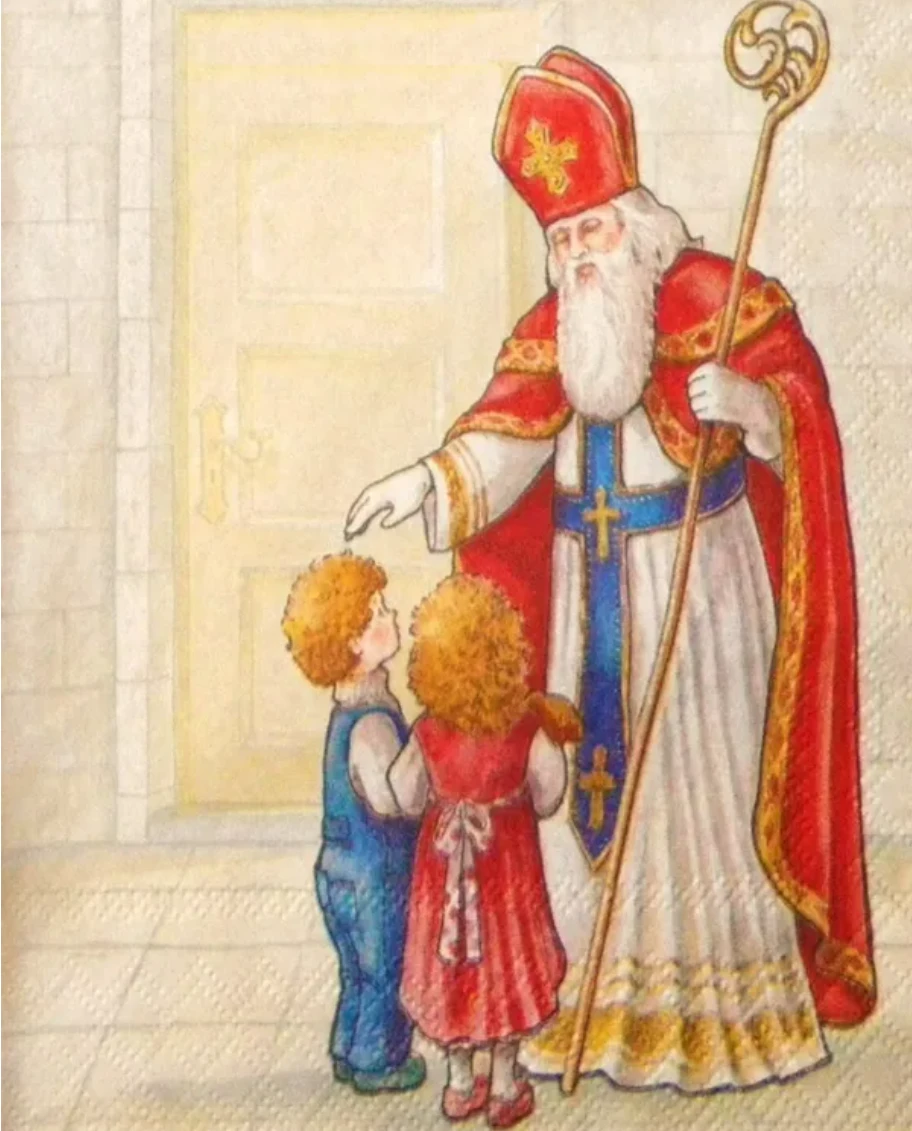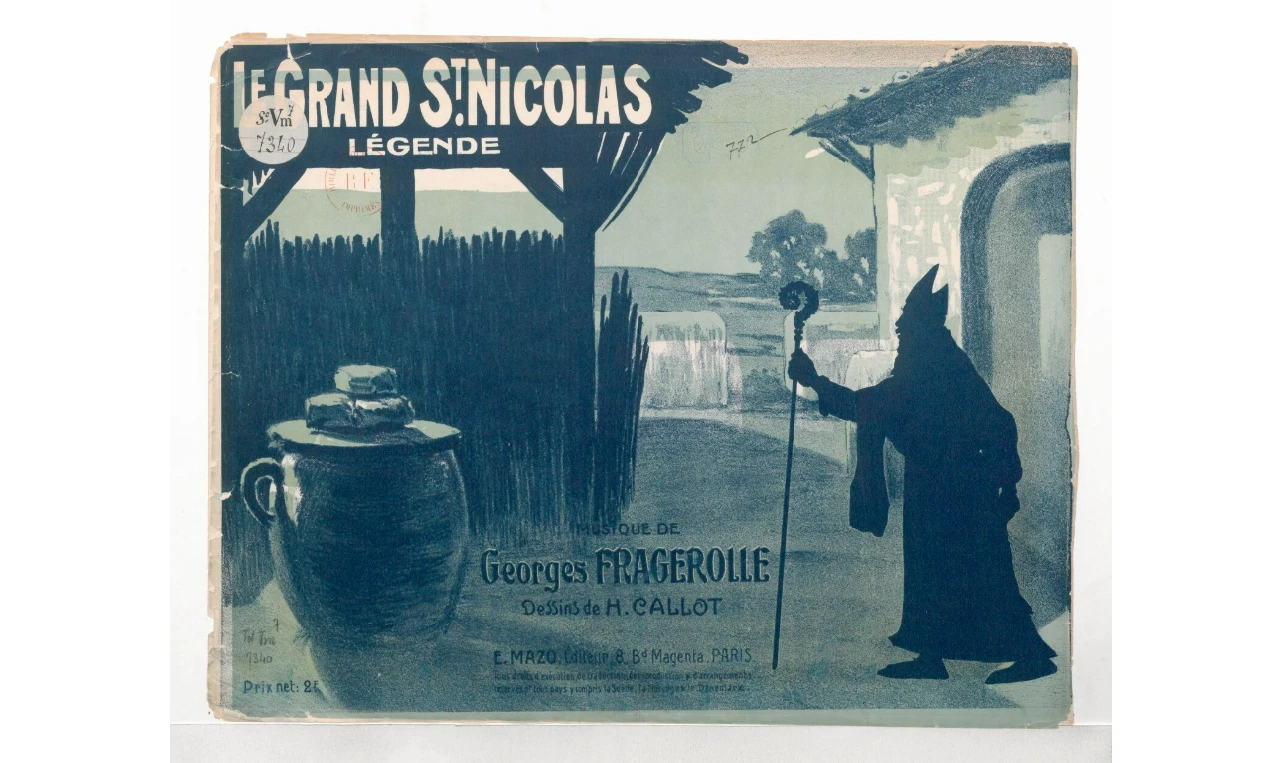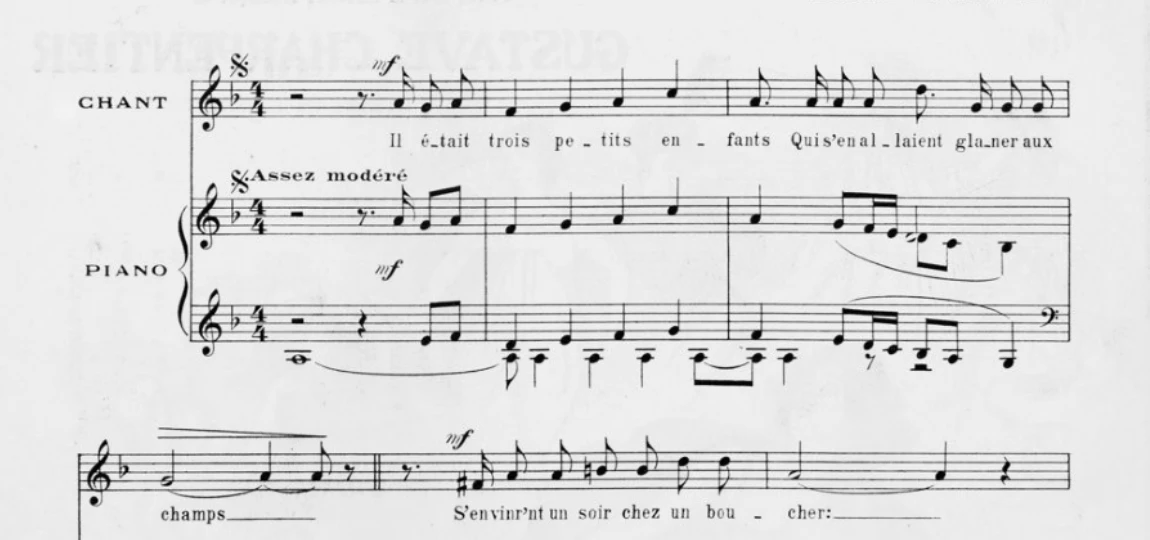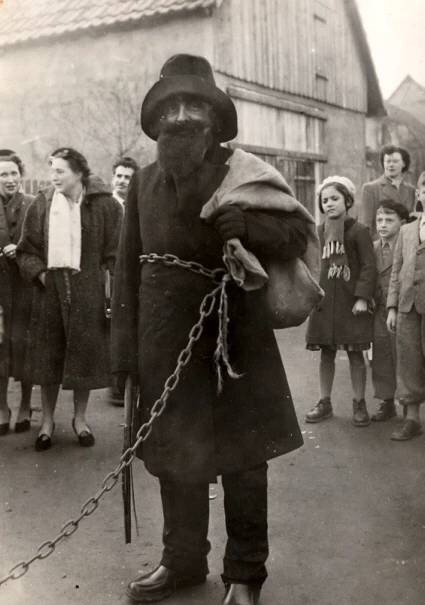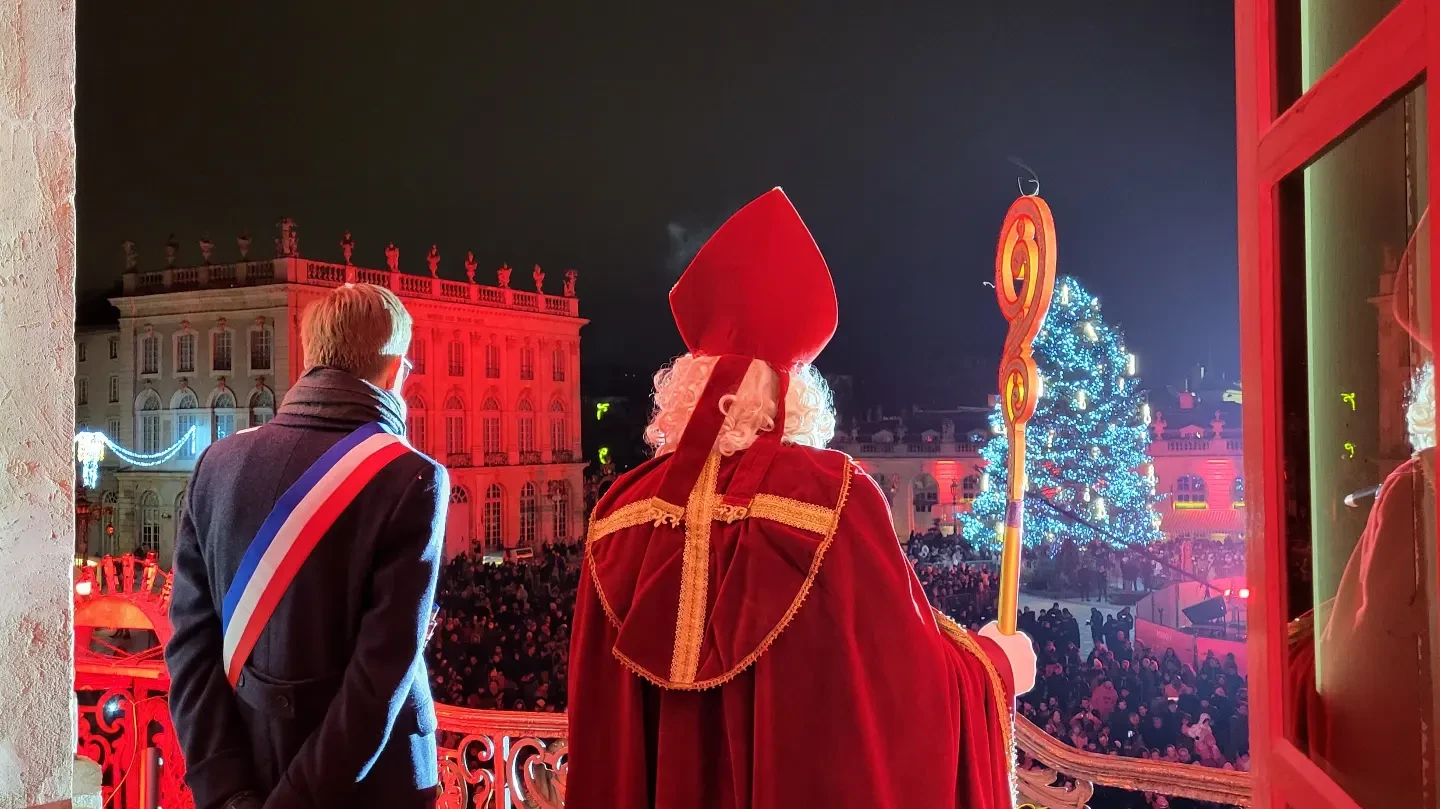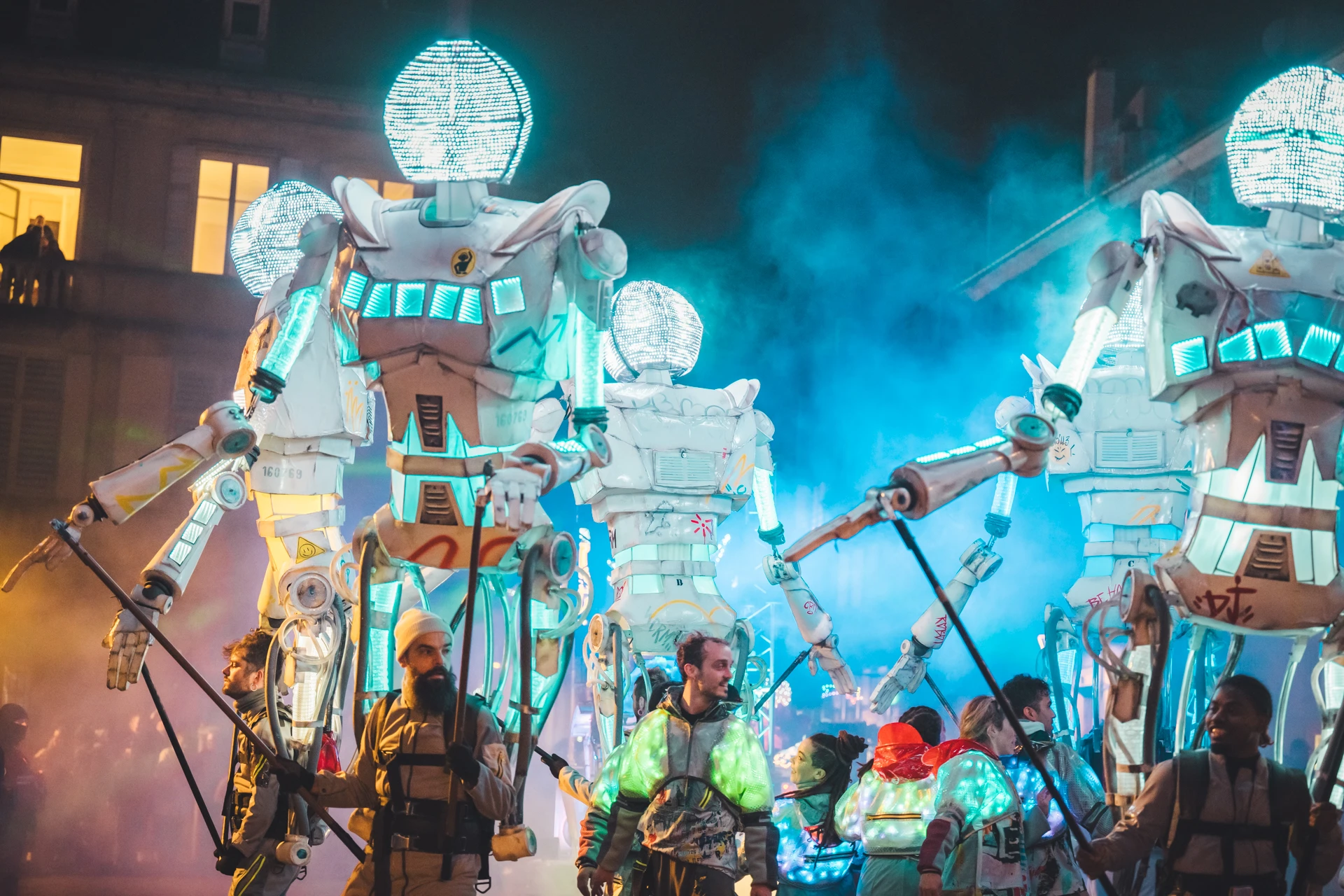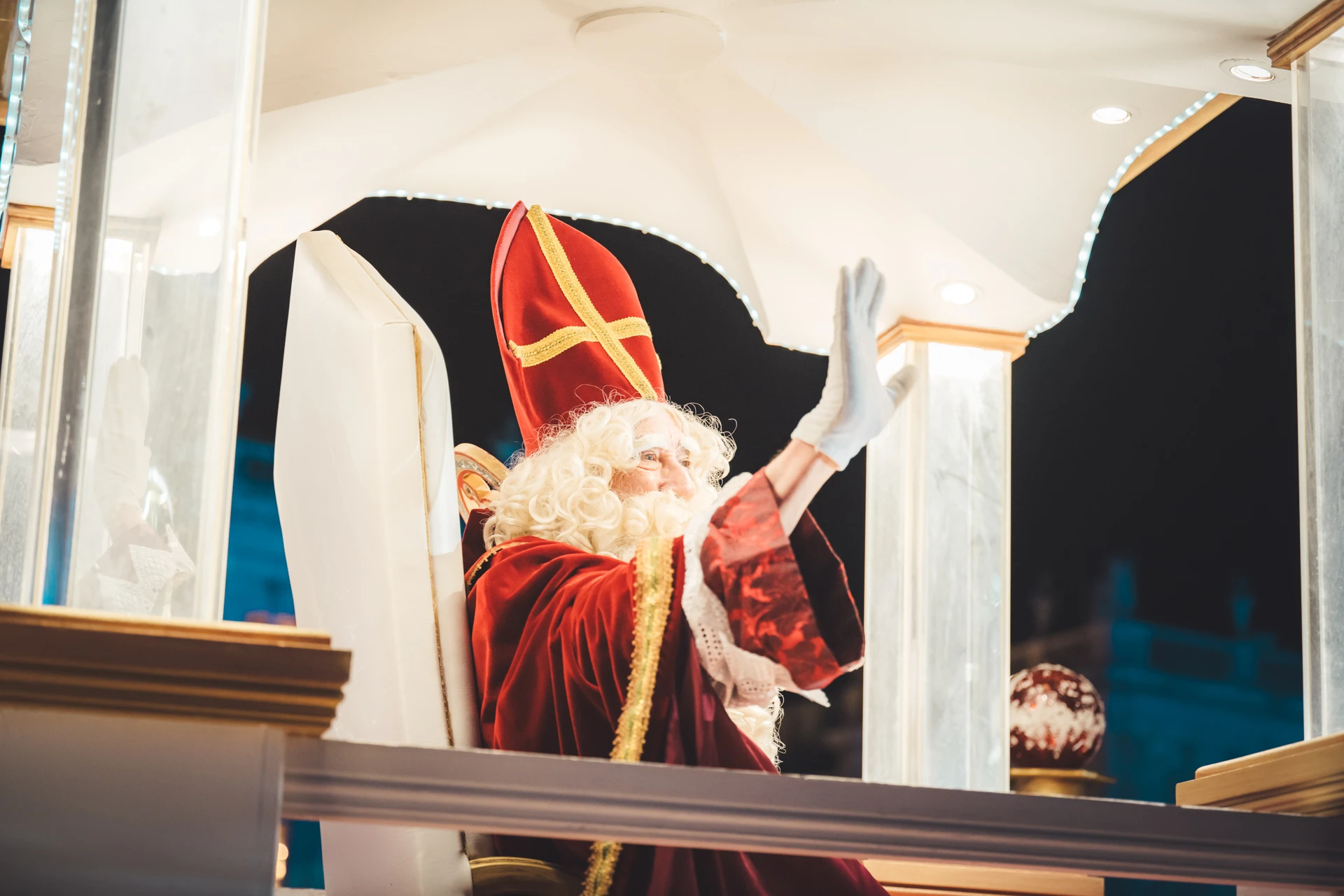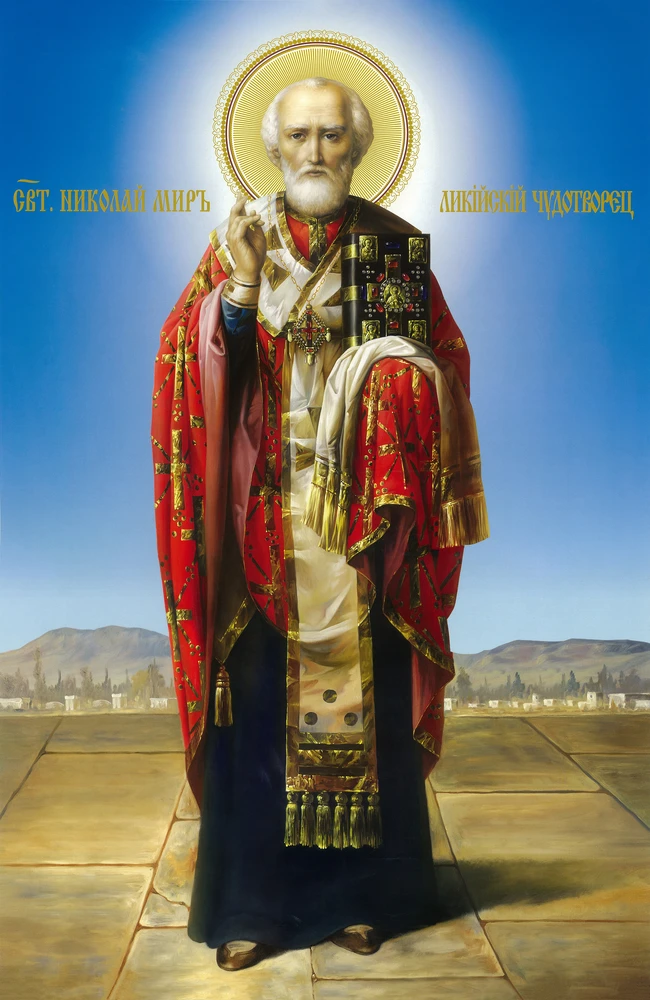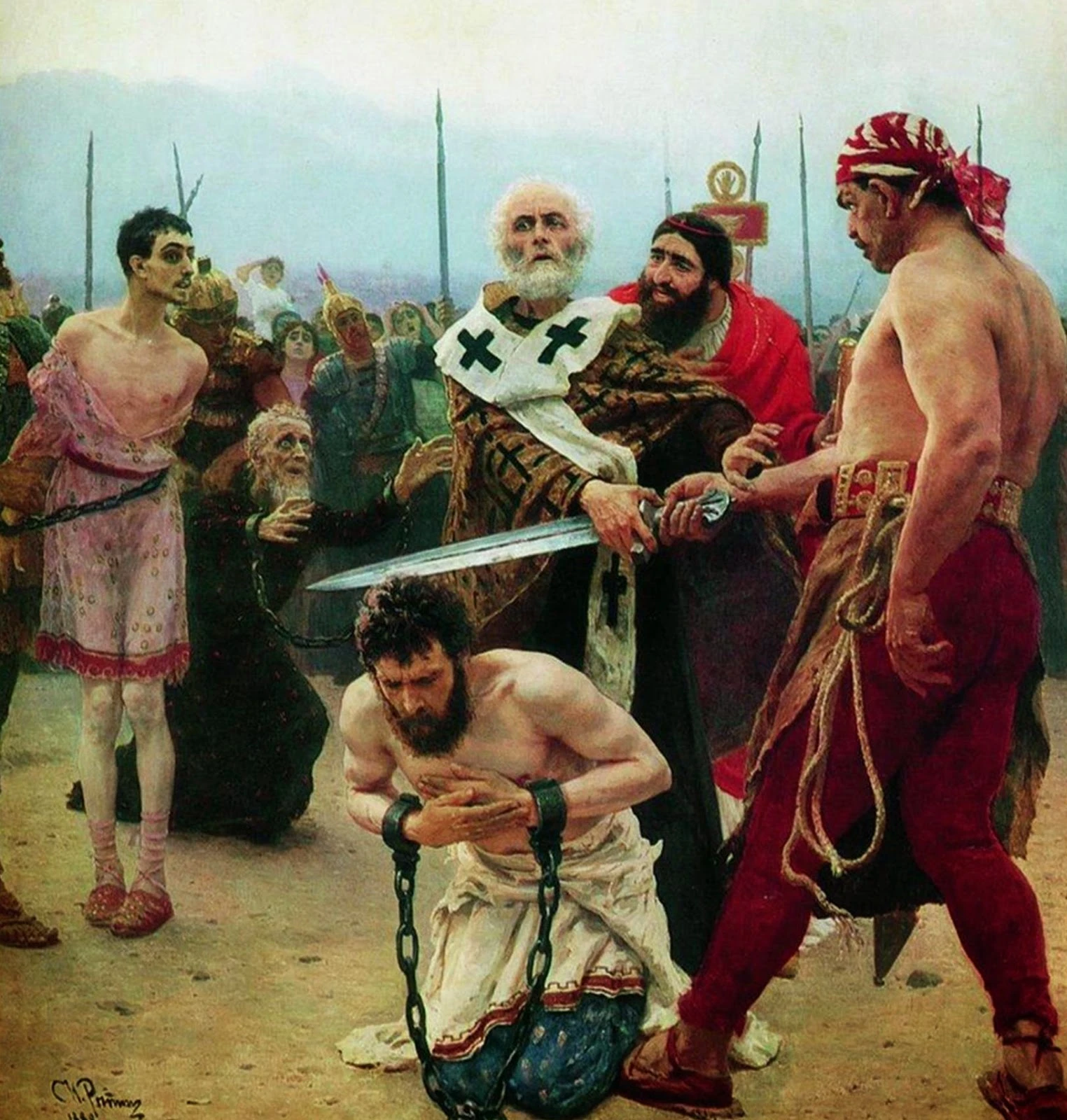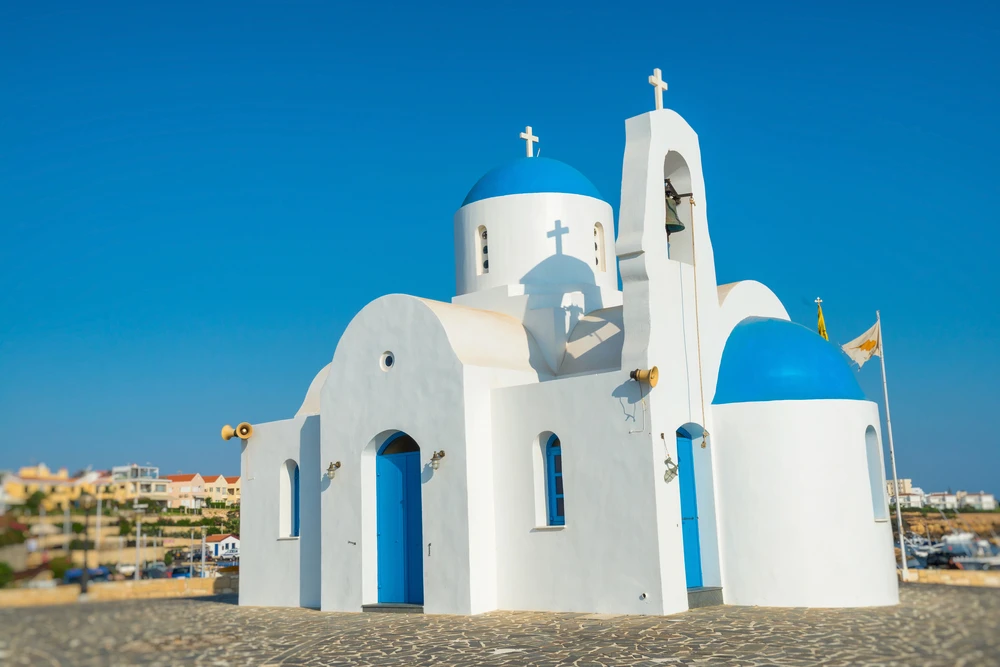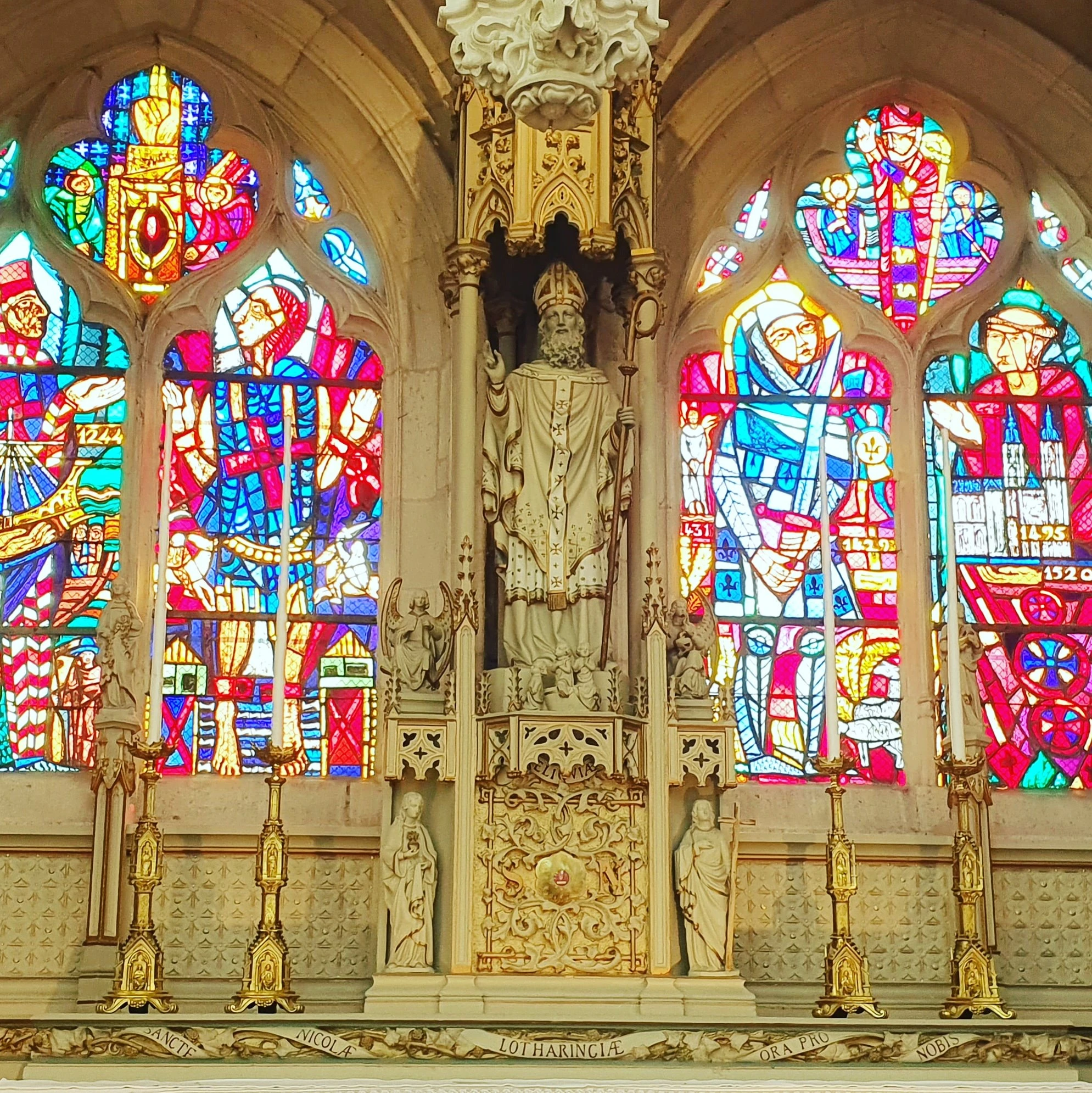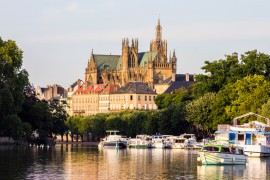Why do we celebrate Saint Nicholas in Lorraine?
Saint Nicholas Day: origins and meaning of the tradition
Every year, on the night of December 5 to 6, Saint Nicholas comes by with his donkey loaded with treats and rewards children who have been good. He is dressed like a bishop with his miter (his hat) and his crozier (his staff). In homes, it is customary to leave a glass of brandy to give Saint Nicholas courage on his journey and a carrot to feed his donkey (or mule). nbsp; He is celebrated in this way in many European countries: the Netherlands, Belgium, Finland, but also parts of Germany, Austria, and others, where festivals and parades are held. In France, celebrations take place in Lorraine, Alsace, and the north. He is always accompanied by his exact opposite: a dark and cruel being who punishes those who have not been good. In Lorraine, it is Père Fouettard or Hans Trap in Alsace. In the Netherlands, it is Schwartze Peter. Elsewhere, in Switzerland for example, it is Schmutzi. In Germany, it is a kind of demon named Krampus.
This is the whole principle behind Saint Nicholas Day, which is why it continues to this day: children see Good and Evil together, and they accept the consequences of their actions: when they have done good, Saint Nicholas rewards them.
illustration chosen by monsieurdefrance.com: old image of Saint Nicholas
In France: where is Saint Nicholas celebrated?
In Lorraine and Alsace, he wears different colors. Red in Nancy, green in Epinal, purple in Metz... Where he is welcomed during small or large parades that pass through the streets so that children can cheer him on and receive candy. The procession of Saint Nicholas would not be complete without its two disturbing characters: Père Fouettard and the butcher. The first, dressed in black, bearded, and armed with a whip, embodies the fear of punishment: he reminds children that bad deeds have consequences. As for the butcher, a central character in the legend of the "three little children," he represents evil defeated by the saint. These two figures, feared but essential, reinforce the moral character of the holiday: good always triumphs over evil.
Traditions of Saint Nicholas in Lorraine: what you need to know
The legend of Saint Nicholas: protector of children
Illustration selected by monsieurdefrance.com via Gallica.fr: Le Grand St-Nicolas, legend, music by Georges Fragerolle, drawings by H. Callot
To understand everything, there is nothing better than Gérard de Nerval's poem, written in 1842, which summarizes the Legend of Saint Nicholas very well:
There were three little children
Who went out to glean in the fields.
They went to a butcher's house in the evening.
"Butcher, would you give us shelter?
Come in, come in, little children, There is certainly room." No sooner had they entered Than the butcher killed them, Cut them into little pieces, Put them in the salting tub like pigs. Put them in the salting tub like pigs.
Seven years later,
Saint Nicholas came to that field.
He went to the butcher's house:
"Butcher, would you give me lodging?"
"Come in, come in, Saint Nicholas,
There's plenty of room."
No sooner had he entered
Than he asked for supper.
"Would you like a piece of ham?"
"I don't want any, it's no good."
"Would you like a piece of veal?"
I don't want any, it's not nice!
I want some salted meat,
That's been in the salting tub for seven years.
When the butcher heard that,
He ran out of his door.
"Butcher, butcher, don't run away,
Repent, God will forgive you."
Saint Nicholas placed three fingers
On the edge of the salting tub:
The first said, "I slept well!"
The second said, "Me too!"
And the third replied:
"I thought I was in heaven!"
It is this legend that makes Saint Nicholas the protector of children.
The melody of Saint Nicholas in 1912. Illustration chosen by monsieurdefrance.com: Gallica.fr
Le Père Fouettard: a figure born in Metz
Dressed in dirty, ragged clothes and sporting a shaggy beard, Père Fouettard carries a whip and follows closely behind Saint Nicholas to punish children who have not been good. Many historians claim that Père Fouettard first appeared in Metz in 1552. The people of Metz created a caricature of Emperor Charles V, who was besieging the city. This caricature, brandished atop the ramparts to mock him, is said to be the origin of Père Fouettard.
Hans Trap, the Alsatian bogeyman in 1953 in Wintzenheim (Alsace, France). Photo selected by monsieurdefrance.com: Wikicommons
PARADES: the heart of the Saint Nicholas celebrations in Lorraine
After receiving the keys to the city from the mayor of Nancy and giving his speech, Saint Nicholas greets the children and the crowd who came to see him during the parade in Nancy. Photo selected by monsieurdefrance.com: Jérôme Prod'homme (c)
In the villages and towns of Lorraine, a large parade is held to welcome Saint Nicholas. Preceded by troupes (brass bands, street performers, etc.) and a float, Saint Nicholas arrives in the town where he is cheered by the people, mainly children, and candy is handed out all around his float. He is accompanied by Père Fouettard and the butcher, who are booed loudly. At the end of the parade, Saint Nicholas is welcomed by the mayor of the city and presented with the keys to the city. He then gives a speech to close the parade. This speech is primarily addressed to children, of whom he is the "patron saint." In some cities, the parade is enormous, such as in Nancy (more than 150,000 people) or Epinal. In Nancy, several tons of candy are distributed during this parade of more than 60 different groups, as is the case in Epinal. But Saint Nicholas Day is not only celebrated in large cities. Villages and small towns also hold their own parades shortly before or after Saint Nicholas Day. They celebrate the protector of children and Lorraine, but not a religious saint. This is the subtlety of the Saint Nicholas celebrations in Lorraine, as they are entirely secular celebrations, even though a bishop is paraded and he is called a saint. In fact, we say "Saint Nicholas" in the same way we would say "Father Christmas" (of whom he is the ancestor).
The Nancy parade in 2024 / Photo Pierre Defontaine / ARTGE
Where can you see the most beautiful parades in Lorraine?
Here are the must-see places for visitors:
Nancy – the most spectacular parade
More than 150,000 people, dozens of floats, marching bands, street performers, illuminations, and tons of candy handed out. It is the largest parade in France dedicated to Saint Nicholas.
Le Saint Nicolas dans son défilé / Photo choisie par Monsieur de France : Pierre Defontaines ARTGE
Épinal – le défilé le plus long
Près de 60 chars le long de la Moselle et une ambiance populaire très familiale.
Saint-Nicolas-de-Port – le cœur spirituel
La basilique abrite une relique du saint.
On peut y vivre une immense procession aux cierges, l’un des moments les plus impressionnants.
Saint-Dié-des-Vosges, Lunéville, Toul, Pont-à-Mousson
Des défilés importants et chaleureux, ancrés dans les traditions locales.
Villages of Lorraine
Each municipality organizes its own parade: small, authentic, family-friendly. An excellent way to experience the festivities "à la Lorraine."
PRACTICAL INFORMATION
When to come?
-
Last weekend of November until December 6
-
Nancy is organizing the "Grand Week-end Saint Nicolas" in 2025, which falls on December 6.
How to get here?
By train:
-
Paris → Nancy: 1 hour 30 minutes (TGV)
-
Paris → Metz: 1 hour 20 minutes (TGV)
By car:
Access via the A31 and A4 highways, ideal from Paris, Luxembourg, Germany, and Belgium.
By plane:
Metz–Nancy–Lorraine or Luxembourg Airport.
Where to park in Nancy?
-
Stanislas Park – Republic
-
Joffre
-
Manufacture
-
Kennedy (Banks of the Meurthe)
-
Exhibition center (shuttle buses to the city center are available).
For families
-
Bring warm clothes
-
A small bag for candy
-
Arrive early to get a good seat
Why not stay overnight?
But you have to start looking well in advance to find accommodation in Nancy, which welcomes 150,000 people for the parade.
The religious origins of Saint Nicholas
Saint Nicholas depicted in an icon. He is very popular in Greece and Russia. Photo selected by monsieurdefrance.com: hramikona@gmail.com via depositphotos.
Saint Nicholas, from a religious point of view, did exist. He was a bishop of Myra, famous for his great kindness and for performing miracles. He is venerated in Bari, Italy, where his body is said to lie. One of his phalanges is venerated in Saint-Nicoles-de-Port, in Lorraine. He is a figure known throughout the world, as he is venerated in many churches around the globe, especially in Russia, where he is the patron saint.
Where does Saint Nicholas come from?
Saint Nicholas of Myra was born in 270 AD in Patara, Lycia, in what is now Turkey. Patara was a port city, and Nicholas's parents were merchants. They died when he was very young, leaving him a large inheritance, which enabled him, in part, to do good deeds. Renowned during his lifetime for his great kindness, he was elected bishop by the inhabitants of Myra, the large neighboring city. Imprisoned during the Christian persecutions, he was reportedly freed when Constantine came to power in Rome and participated in the Council of Nicaea (325), the founding council of the Christian church. It was during this council that it was decided that only four gospels would be considered official. He died in Myra in the year 343. His tomb was discovered not long ago.
Saint Nicholas: the bishop of Myra and his legend
He saves three young girls.
Saint Nicholas, Bishop of Myra, is known for several miracles that made him popular in both the East and the West. He is even a spiritual link between the two parts.
While the whole family sleeps, Saint Nicholas gives three bags of gold to save the young girls whose father wants to prostitute them. Illustration chosen by Monsieurdefrance.com: Palmerino di Guido — Web Gallery of Art: Image Info about artwork, Public domain, https://commons.wikimedia.org/w/index.php?curid=15610919
The oldest writings tell us that he saved three young girls whose father wanted to prostitute them to pay off his debts. At night, so as not to be seen and to remain modest in his help, Nicholas is said to have left the money needed to pay off the unworthy father's debt and prevent him from prostituting his daughters. It is because of this story that Saint Nicholas is the patron saint of young girls.
He saves three sailors.
Ancient religious chronicles also tell of a miracle on the water that made Saint Nicholas the patron saint of sailors and boatmen. While lost in a storm at sea, sailors called on Saint Nicholas for help and, although he was in Myra, he appeared on the deck of the ship and encouraged the sailors before taking the helm himself and saving them. Once ashore, the sailors went to Myra to thank him for saving them.
He saves three soldiers.
Saint Nicholas preventing the execution of unjustly accused soldiers. Illustration selected by monsieurdefrance.com: Ilia Repin, Public domain, via Wikimedia Commons
It is also said that Saint Nicholas left Myra to travel to Constantinople and defend three soldiers who had been wrongly accused of plotting against the Emperor. Saint Nicholas arrived just in time and not only saved the lives of the three soldiers, but also proved that the plot had been hatched by a local tyrant and soldiers jealous of the accused soldiers' success. It is because of this episode that Saint Nicholas is the patron saint of lawyers. As the three soldiers were single, Saint Nicholas is also the patron saint of young men seeking marriage.
The miracle of wheat
While the city of Myra was starving, Saint Nicholas managed to convince sailors to leave part of their wheat cargo to feed the city. When they arrived in Constantinople, the sailors found that there was as much wheat in their ship as if they had given nothing to the citizens of Myra.
Saint Nicholas Patron Saint
Through his life and work, Saint Nicholas is the patron saint of many places, professions, and causes. For example, in terms of geography, he is the patron saint of Lorraine, Russia, New York City, Greece, Fribourg in Switzerland, Heupen in Belgium, and the University of Valladolid. He is the patron saint of children, prisoners, travelers, schoolchildren, unmarried boys, lawyers, pawnbrokers, young girls of marriageable age, coopers (who made salting tubs) and grocers. He is also the patron saint of sailors and boatmen.
The Church of Saint Nicholas in Protaras on the island of Cyprus. Photo selected by monsieurdefrance.Com: KirllM via depositphotos.
Children and Saint Nicholas: a story of ladders
In the Basilica of Saint Nicolas de Port, in Lorraine, Saint Nicolas is recognizable by his bishop's robes and the three small children accompanying him. Photo selected by Monsieurdefrance.com: Jérôme Prod'homme (c)
You may have noticed that there is no connection between the life of Nicholas of Myra and children. In fact, the legend of the three little children came about long after Saint Nicholas' religious life. It probably originated as a way of representing the saint. Let me explain: what changed things were drawings. In the Middle Ages, to make things clear, it was customary to depict the central character, often a saint, larger than the others to show his greatness. Thus, when Saint Nicholas is depicted, he is often shown with the three soldiers he saved from an unjust sentence. Simple soldiers and a great saint, medieval illuminators took to depicting Saint Nicholas as very tall, and the soldiers in a tower to remind viewers of their profession. Over time, and with the famous legend that probably dates back to the Middle Ages, the soldiers became children, and the tower became a salting tub, showing Saint Nicholas resurrecting three small children and thus recalling the legend rather than religious history.
FAQ – Saint Nicholas in Lorraine
Why do we celebrate Saint Nicholas Day on December 6?
Because the saint's feast day falls on that day and the tradition has continued.
What is the difference between Saint Nicholas and Santa Claus?
Saint Nicholas is the original (4th century). Santa Claus is his modern evolution.
Where can you see the best fashion show?
In Nancy, the most spectacular.
Why is the butcher present?
Because he embodies the villain in the legend of the "three little children."
Why does Père Fouettard accompany Saint Nicholas?
He symbolizes the opposite of the saint: punishment versus reward.
Does Saint Nicholas visit schools?
Yes, in Lorraine, Alsace, and the North.
What treats are offered?
Gingerbread, candies, chocolates, clementines.
Can we visit the Basilica of Saint-Nicolas-de-Port?
Yes, it houses a relic and, above all, it is magnificent.
Where does Père Fouettard come from?
From a caricature of Charles V made in Metz in 1552.
Is Saint Nicholas celebrated elsewhere?
Yes: Belgium, the Netherlands, Germany, Austria, Switzerland, Finland, etc.

